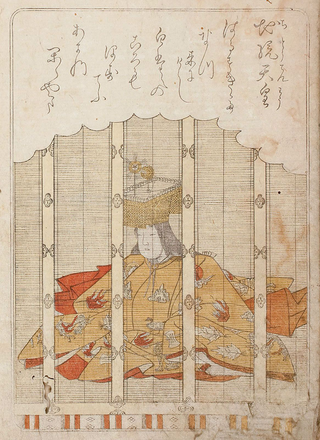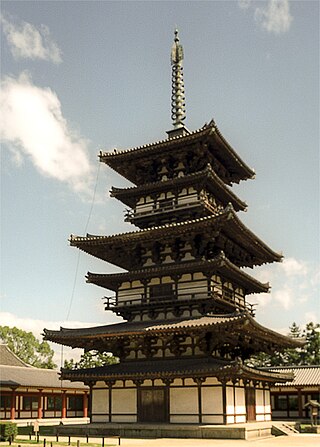Emperor Tenji, known first as Prince Katsuragi and later as Prince Nakano Ōe until his accession, was the 38th emperor of Japan who reigned from 668 to 671. He was the son of Emperor Jomei and Empress Kōgyoku, and his children included Empress Jitō, Empress Genmei, and Emperor Kōbun.
Emperor Kōbun was the 39th emperor of Japan, according to the traditional order of succession.

Emperor Tenmu was the 40th Emperor of Japan, according to the traditional order of succession. He ascended to the throne following the Jinshin War, during which his army defeated that of Emperor Kōbun. Tenmu reigned from 673 until his death in 686, amid Hakuhō period or the late Asuka period.

Empress Jitō was the 41st monarch of Japan, according to the traditional order of succession.

Emperor Monmu was the 42nd emperor of Japan, according to the traditional order of succession.

The Japanese era name or nengō, is the first of the two elements that identify years in the Japanese era calendar scheme. The second element is a number which indicates the year number within the era meaning "origin, basis", followed by the literal "nen (年)" meaning "year".

Shōgen (正元) was a Japanese era name after Shōka and before Bun'ō. This period spanned the years from March 1259 through April 1260. The reigning emperors were Go-Fukakusa-tennō (後深草天皇) and Kameyama-tennō (亀山天皇).

Taihō (大宝) was a Japanese era name after a late 7th century interruption in the sequence of nengō after Shuchō and before Keiun. This period spanned the years from March 701 through May 704. The reigning emperor was Monmu-tennō (文武天皇).

Chōgen (長元) was a Japanese era name after Manju and before Chōryaku. This period spanned the years from July 1028 through April 1037. The reigning emperors were Go-Ichijō-tennō (後一条天皇) and Go-Suzaku-tennō (後朱雀天皇).

Keiun (慶雲), also known as Kyōun, was a Japanese era name following Taihō and preceding Wadō. The period spanned the years from May 704 through January 708. The reigning emperors were Monmu-tennō (文武天皇) and Genmei-tennō (元明天皇).

Shuchō (朱鳥), alternatively read as Suchō or Akamitori, was a Japanese era name after a gap following Hakuchi (650–654) and before another gap lasting until Taihō (701–704). This Shuchō period briefly spanned a period of mere months, June through September 686. The reigning sovereigns were Tenmu-tennō (天武天皇) and Jitō-tennō (持統天皇).

Taika (大化) was a Japanese era name during the reign of Kōtoku. The Taika era immediately preceded the Hakuchi era. This period spanned the years from August 645 through February 650.

Hakuchi (白雉) was a Japanese era name after the Taika era and before Shuchō. This period spanned the years from February 650 through December 654. The reigning emperor was Kōtoku-tennō (孝徳天皇).

The Saimei period is a chronological timeframe during the Asuka period of Japanese history. The Saimei period describes a span of years which were considered to have begun in the 1315th year of the imperial dynasty.

The Tenji period is a brief span of years during the Asuka period of Japanese history. The Tenji period describes a span of years which were considered to have begun in the 1322nd year of the imperial dynasty.

The Kōbun period is a chronological timeframe during the Asuka period of Japanese history. The Kōbun period describes a span of years which were considered to have begun in the 1332nd year of the imperial dynasty.

The Jitō period is a chronological timeframe during the Asuka period of Japanese history. The Jitō period describes a span of years which were considered to have begun in the 1347th year of the imperial dynasty.

The Monmu period is a chronological timeframe during the Asuka period of Japanese history. The Mommu period describes a span of years which were considered to have begun in the 1357th year of the imperial dynasty.

Ten'ō (天応) was a Japanese era name after Hōki and before Enryaku. This period lasted from January 781 through August 782. The reigning emperor was Kōnin-tennō (光仁天皇).

The Hakuhō period was an unofficial Japanese era name of Emperor Tenmu after Hakuchi and before Suchō. The duration of this discrete non-nengō timespan lasted from 673 through 686.







